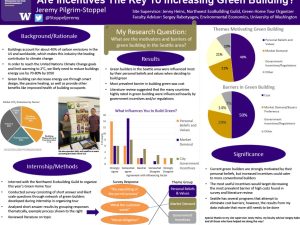Incentives Could Be The Key To More Green Building
Buildings produce around 40% of carbon emissions across the world. In order to reach the goal set by the Paris Climate Accord of only 2 degrees Celsius warming we need to use green building to reduce these carbon emissions. My study looked to identify what the barriers and motivators of green building were in the Seattle area. I conducted a literature review to understand what common influences are in green building. I then conducted a survey of green builders in the Seattle area to understand how their experiences differed or remained the same. I found that personal values and beliefs along with market demand were the largest motivators. The most commonly identified barrier to green building was cost, both in my survey of green builders and in my literature review of barriers among all builders. These results show that those who are currently building green are primarily motivated by personal beliefs and values while government incentives are underutilized to offset expensive first costs. These findings are important because if we believe staying below 2 degree Celsius is important to our goals then we need to increase incentives to mitigate the barrier of expensive costs and to bring more conventional builders without the initial personal beliefs driving their decision into green building.
